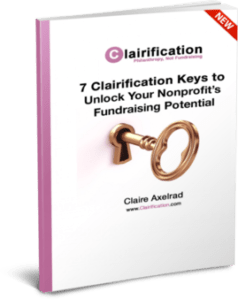
Does your board make decisions grounded in tomorrow, today or yesterday?
Many nonprofits are stuck.
They’re tethered to their early decisions. Often made by others who came before them.
But times change. Organizations evolve.
Or they don’t.
The organizations that don’t adapt to changing times are often those that fail to make new decisions. They’re the ones who say “that’s not how we do things here.” Or they poo-poo decisions made by new folks who come on the scene, saying “they don’t understand our culture.”
These are the organizations that tend to shrink over time. They lose their energy. Their once-vital raison d’etre becomes less urgent. And their appeal to donors diminishes.
When organizations fail to make fresh decisions, they become less relevant.
I recently listened to Jerry Panas, one of the most revered fundraisers in our country, talk about what he called the “deficit of mission.” He made it very clear that boards have two critical roles:
(1) Boards hire/fire the CEO, and
(2) Boards prevent a deficit in mission.
As you read this, I know your eyes may be glazing over as you think “yeah, yeah… we all know this.” But these decisions, made by the board of directors, are everything.
What I’ve found is that in foundering organizations, the board fails to execute in one or both of these areas. In the first case, there may be a “founder” who has simply been around too long. Or a long-tenured leader who simply no longer is bringing much to the table. In the second case, there may be a tendency to cut expenses to prevent a budget deficit. While this may be a short-term fix, it often paves the way for long-term disaster as your mission contracts.
Does your board have the guts to fire your CEO?
Too many organizations are hampered by so-called leaders who are no longer really leading. They’re either resting on their laurels, or they’re taking the organization off on tangents that cloud the organization’s purpose. It seems like heresy to say so, yet it’s all people talk about behind closed doors. While folks are grateful for their leader’s past contributions, they’re troubled by the current state of affairs.
A much better strategy would be making a new decision. Perhaps to find a new role for a leader who’s no longer functioning optimally? And then to bring in someone new who can take the organization where it needs to go in the current environment. I’m not suggesting you make such a decision lightly. But sometimes it’s the best decision to make. For everyone.
Does your board have the guts to commit to fundraising?
Fixing a projected deficit should be part of a complex decision-making process. Anyone can slash a budget. But when you cut expenses, you do so at a cost to your mission. Programs that have been slashed sometimes never come back. And when they leave, they take the donors who supported them. And the would-be donors who may have been attracted to them.
A much better strategy would be making a new decision. Perhaps to roll up your sleeves and raise the money needed to support the mission? And then to make the necessary investment in fundraising to generate contribution income in the current environment. A nonprofit board has a special fiduciary role and responsibility to assure fulfillment of the organization’s mission. Money must come in the doors.
Does your board have the guts to make new decisions?
Is your organization stuck? Is your board complacent?
If so, you may be engaging in what thought leader Seth Godin calls decision making, after the fact. In other words, your leaders may accept as fact that which they casually observe. This leads to erroneous thinking (e.g., The way things have been done in the past is how they should always be done in the future; Why rock the boat?)
While this may seem like playing it safe, in reality it’s quite risky. Because our world, post-digital revolution, is changing at a rapid pace. The boat is already rocking, and nothing the board does will take things back to the past.
Boards must make complex decisions that take into account many factors – including the fact that today’s world is not yesterday’s, nor will it be tomorrow’s.
Complex decision making is a skill—it can be learned, and some people are significantly better at it than others. It involves instinct, without a doubt, but also the ability to gather information that seems irrelevant, to ignore information that seems urgent, to patiently consider not just the short term but the long term implications.
The loudest critics have poor track records in every one of these areas.
Mostly, making good decisions involves beginning with a commitment to make a decision. That’s the hard part. Choosing the best possible path is only possible after you’ve established that you’ve got the guts and the commitment to make a decision.
— Seth Godin [emphasis added]
What gets in the way of good decision-making?
We have a tendency to search for or interpret information in a way that confirms our preconceptions. We can’t see outside the box we’re in.
- Confirmation bias occurs when boards get stale. Does yours have term limits?
- Confirmation bias occurs when board orientation is minimal, and new members are discouraged from doing anything that deviates from the herd mentality.
- Avoiding confirmation bias requires a widening of vision, and a willingness to take some risks.
Decisions must be reality-based. Made with eyes wide open, not through rose-colored glasses.
What else gets in the way of good decision-making?
Emotion.
Board members can become unbelievably attached to programs that no longer make sense. There may no longer be a justifiable market for the program, or expenses may have risen to the point that the program is no longer cost-effective. Sometimes the programs are mission-focused; other times they’re Galas or other “fundraising” events that cost more than they generate.
I’ve had good success paring back events once I’ve presented boards with the real costs associated with those shindigs, but even then emotion can rear its ugly head. I’ve lost some folks along the way (but that was okay).
To avoid making decisions based on emotion, not reason, requires getting some distance from the problem. It’s not always possible to do this from the inside; you may benefit from bringing in an outside consultant. For example, I once brought in a marketing expert to review our programs dispassionately. She looked at expenses, revenues, number of people served and ratio of staff to clients — giving us a much better idea of both (1) the real cost of these programs and (2) the lost opportunity costs. There were still folks who said “I don’t care what it costs – it’s part of our mission,” but at least we could now move forward with facts underpinning decision-making.
Absent hiring a consultant, it can help to adopt an outsider perspective.
Ask yourself: What would an unbiased person, who isn’t caught up in your organizational history, do?
Fight the emotional, status quo bias by asking:
- If we weren’t already running this program, would we start funding it today?
- How long will this program last?
- If we make this decision, how will it look six months from now? A year? Five years?
- Does this align with our current core priorities?
- Is there a better decision that would be more aligned with our mission moving forward?
What prevents boards from making new decisions?
Fear of failure.
Boards are naturally risk averse.
It’s their job, after all, to be good stewards of donor resources. Yet in our digitally revolutionized world, where change happens at the speed of light (or faster!), nonprofits have to take risks. They have to be nimble. They have to adapt. And they have to embrace failure. If they don’t fail, they don’t grow. And if they don’t grow, they die.
I’ve not run into many boards willing to embrace failure.
And why would they? This is just their volunteer job. They don’t want to be sued. It wouldn’t sit well, and it wouldn’t look good on their resume. Fear is a powerful emotion that can lead to dangerous “group think,” leading to emotion-driven decisions that can sometimes be quite irrational. Introducing new ideas can become a political mine field, and almost as challenging as trying to get a bill through today’s Congress.
Summary
Complex decisions are often fraught with things that get in the way. Past decisions. Confirmation bias. People’s emotions. Fear of failure.
No decisions guarantee certainty.
But you’ll make better decisions for the long-term, and better succeed in furthering your mission and being there for the people who rely on and need you, if you:
- Commit to making decisions, even the hard, complex and sometimes gut-wrenching ones.
- Work to eliminate your biases.
- Attempt to attain some distance before deciding.
- Hold your emotions in check.
For more on this topic, may I suggest Dan and Chip Heath’s book, Decisive: How to Make Better Choices in Life and Work. Based on an exhaustive study of decision-making literature, the authors introduce a process designed to ensure we don’t overlook precious opportunities to change our course.
To your decision-making success!
Want to get your staff and board on the same page so you can make better decisions together?

Tips, tools, templates, exercises, worksheets and checklists galore!
Unlock your nonprofit’s fundraising potential through a series of “clairifying” worksheets and exercises. (1) Values. (2) Stories. (3) Brand. (4) Social Channels. (5) Support Constituencies. (6) Engagement Objectives. (7) Resources and Systems. Work through the exercises in the 7 Clairification Keys to Unlock Your Nonprofit’s Fundraising Potential together. It will put the focus on issues, not personalities. And I guarantee you’ll learn a lot. And if you’re not satisfied, you can request a full refund within 30 days. No questions asked. So… what have you got to lose? Go for it — it’s not even a complex decision!
-
Pingback: Key Issues in Effective Nonprofit Board Decision-Making - NonProfit PRO





